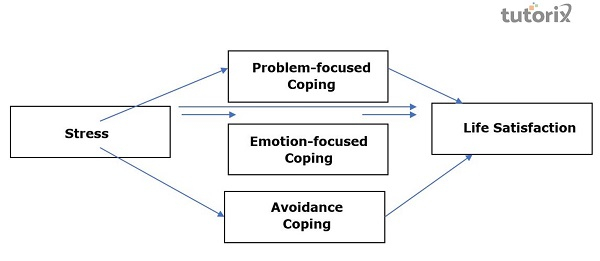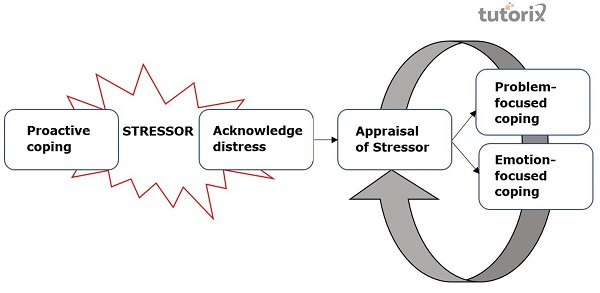Coping with Stress
PsychologyAbnormal Psychology
The term "coping" has become commonplace in popular culture. People of all ages encounter stress and attempt to cope with it. People develop coping mechanisms for stress during their early years due to numerous unpleasant situations. People deal with stress in various ways. Sometimes people confront a problem directly and rationally, and sometimes they try to escape from or avoid the things they find threatening.
What is the Meaning of Coping with Stress?
Although the psychological definition of coping is not far removed from the popular usage of the term, a precise definition is essential to understand the concept of coping. "Coping consists of efforts, both action-oriented and intrapsychic, to manage (i.e., master, tolerate, reduce or minimize) environmental and internal demands and conflicts among them" (Lazarus and Launier, 1978). People try to cope when they deal with the perceived discrepancy between the demands of a stressful situation and their ability to meet those demands.
Coping is a dynamic process. An individual may attempt several coping strategies, and feedback about the success of one type of effort typically spurs the person on to try it again, whereas failure encourages an individual to try a different approach or possibly give up altogether. The individual continually appraises and reappraises the environment and his or her efforts at coping with it.
Coping Models
It includes −
- Parker and Endler's Task-Oriented, Emotion-Oriented, and Avoidance-Oriented Coping (1992) − Many stress theorists believe that individuals tend to approach and respond to a range of stressful situations using a consistent style. According to Endler and Parker (1992), coping styles can be categorized into three general types.
- Task-oriented coping involves strategies aimed at taking direct action to modify the situation or generating alternative solutions to reduce the amount of stress the situation evokes.
- Emotion-focused coping is person-oriented and is directed at regulating emotions cued by the stressor. It also included attempts to reframe the problem so that it no longer evokes a negative emotional response and elicits less stress. This coping style may comprise affective responses such as outbursts or fantasizing reactions.
- Avoidance-oriented coping responses are either task-oriented (e.g., distracting oneself with another task) or person-oriented (e.g., social diversion such as seeking out others) and are generally directed at avoiding the implications of a threatening event or denying its existence. It includes indirect efforts to adjust to stressors by distancing oneself, evading the problem, or engaging in unrelated activities to reduce the feelings of stress.

- Lazarus and Folkman's Problem-Focused and Emotion-Focused Coping (1984) − Lazarus and Folkman (1984) distinguished two basic coping categories, i.e., problem-focused and emotion-focused coping, as responses intended to "manage or improve the situation producing the discomfort" and "controlling emotional responses to the problem," respectively.
- Problem-focused coping (also known as problem-solving efforts) involves taking direct action to change a stressful situation or to prevent or reduce its effect. The objective of problem-focused coping is to reduce the demands of the situation or enhance one's resources to deal with it. Applying for a loan to pay overdue bills is a good example of problem-focused coping. Problem-focused coping can even begin ahead of the occurrence of the problem. This approach is called proactive coping. In this case, the individual anticipates potential causes of stress and does things to plan for the situation. Using proactive coping does not mean that one will never encounter a stressor, but it can enable a person to be better prepared to handle it. People tend to use problem-focused coping when they believe that there is something that they can do about the stressful situation they face.
- Emotion-focused coping involves attempts to regulate or reduce the stressful event's emotional and relatedly social consequences. The individual puts in efforts to regulate his or her emotions. For example, when faced with the breakup of a romantic relationship, people may try to cope with their feelings of distress by distracting their attention with day-to-day activities. In response to stressful events, emotion-focused coping may also involve cognitively re-evaluating the situation, seeking emotional support and reassurance from other people, trying to accept the problem if one can do nothing, and discharging emotions.

Lazarus and Folkman have made an important contribution to the conceptualization of coping, searching its structure and influence on forming many other coping models. However, the distinction between problem-focused coping and emotion-focused coping has been criticized by many researchers over the years. Skinner et al. (2003) stated that most ways of coping could serve both functions and thus fit into both categories. For example, making a plan not only guides problem-solving but also calms emotions. Similarly, Compas et al. (2001) noted that a single coping strategy might be focused on the problem and the emotions. Thus, problem-focused versus emotion-focused coping is not conceptually clear. Furthermore, this distinction is not exhaustive as it leaves out social support seeking.
Conclusion
Since the early 1980s, researchers have moved away from viewing copying as an unconsciously employed defense mechanism. Instead, coping is now widely conceptualized as a conscious response to external events. There is also evidence that individuals have preferences or stylistic patterns in their coping reactions to stressful situations. However, the adequate measure of successful coping will likely be multifaceted. When coping well, an individual is expected to report a reduction in his or her feelings of psychological distress along with physiological signs such as reduced heart rate, breathing rate, and muscle tension. Complex, multifaceted measures are necessary to give an accurate picture of the quality and effectiveness of coping.



